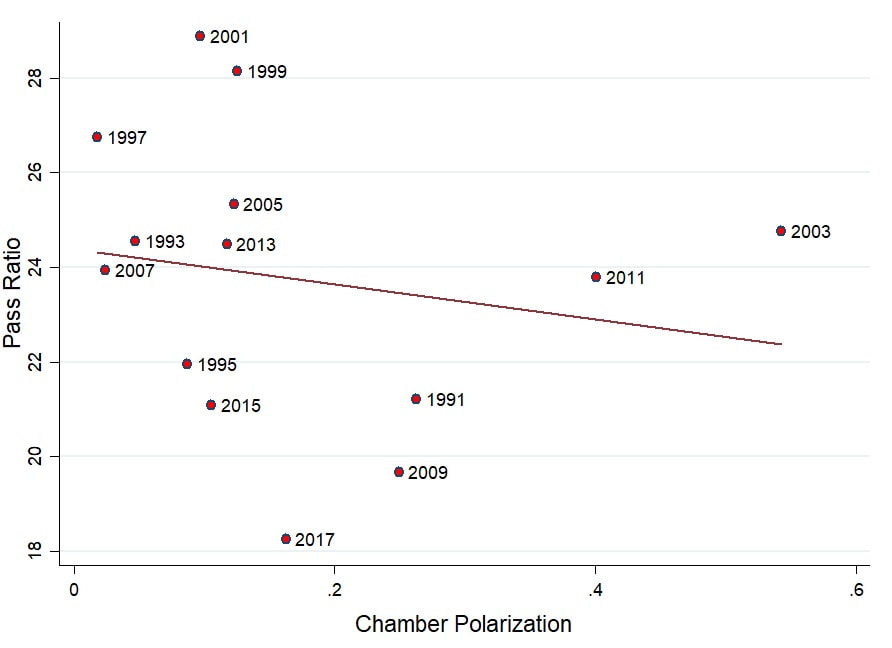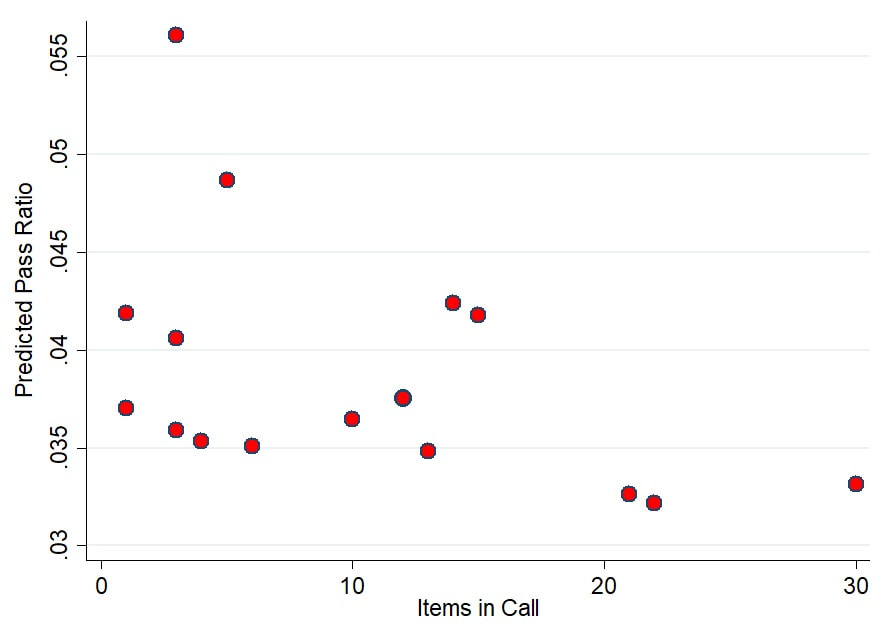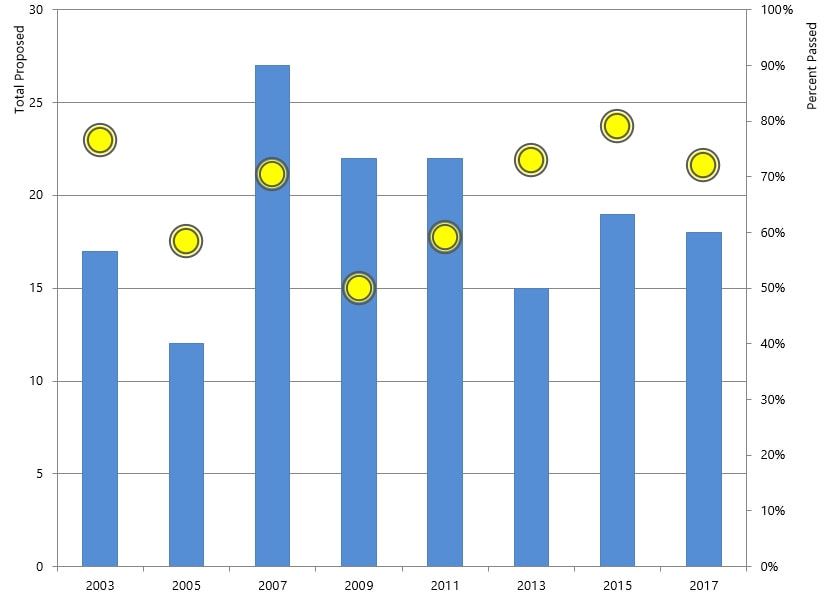|
A Tale of Two Chambers The epic levels of distrust between the Texas House and Senate (exacerbated by personal tension) has shaped many of the state’s legislative sessions, especially the 85th regular session. Chamber differences, however, are as old as the Republic itself. The first Congress of the Republic was tasked with the responsibility to select a site for a permanent capital. Predictably, House and Senate committees failed to agree – the House preferred Nacogdoches and the Senate preferred San Jacinto. A joint vote of both chambers was called and Houston was eventually selected (see note!). Is this friction between the chambers producing less legislation? Sort of. At least partially. The graph below displays ideological differences between the House and Senate of ideal point estimates for members of each chamber from 1991 to 2017 who voted in the majority and the percentage of bills passed out of those introduced.* In essence, the measure captures chamber differences in the ideologies of those voting in the majority and how bipartisan (scores around .5) or extreme (scores around 0 or 1) the legislation voted on was. The 85th (2017) session wasn’t as ideologically split by chamber as others (like the 78th session in 2003, which precipitated special sessions where Democrats fled the state to break a quorum), but pass ratio was much lower. The downward slope of the linear fit of the data reveal a modest effect of chamber polarization on overall legislative productivity.
These are mass indicators (overall pass rates), so we miss the nuance on specific important legislation (ie, the bathroom bill). Also, the chambers don’t necessarily vote on the same issues. It does give us an average indicator of how chamber differences in the ideology of legislation may dampen overall output. * Data nerd stuff: The ratio of introduced to passed bills is calculated as the total bills passed out of those introduced. Ideal point differences were calculated using the mean ideal point of those who voted in the majority and taking the absolute value difference between the chambers. Ideal point estimations from Shor and McCarty ideological scores, provided generously by Boris Shor. The absolute value of the difference between House and Senate members was then calculated. Note: Check out the great A Political History of the Texas Republic, 1836-1845 by Stanley Siegel for more fascinating detail. With (Very) Little Help to His Friends
Governor Abbott said in remarks at a Texas Public Policy Foundation special session preview that he would be “establishing a list” to call out reluctant legislators who didn’t back him on special session items. Ominously, he added, “No one gets to hide.” One way the Governor with a massive $41 million war chest can help his allies (or punish his enemies) is to lavish their campaign accounts with fund. The evidence, though, doesn’t show generosity to individual candidates but rather an enrichment of the Republican Party more generally. Texas Ethics Commission reports for “Texans For Greg Abbott” (the main fundraising arm of the Abbott campaign) show almost $100,000 in expenditures to various arms of the Republican Party between 2014 and July 2017.* October 2014 (30 Day) Republican Party of Texas, $30,000 July 2015 (July Semi-Annual) Texas Federation of Republican Women PAC, $500 July 2016 (Semi-Annual) Caldwell County Republican Party, $300 Republican Party of Texas, $50,000 January 2017 (Semi-Annual) Associated Republicans of Texas, $7,500 Republican Party of Texas, $11,900 July 2017 (Semi-Annual) Texas Federation of Republican Women PAC, $500 This is not to suggest that the Governor can’t help friends and allies by campaigning with them or lending his name or presence to a fundraiser. He has said recently that he would be “involved” in the 2018 primaries. But these numbers suggest that direct financial campaign assistance is small. * These reports are massive, so .csv files were sorted and searched for “political” or “donation” or “contribution.” Figures do not include hundreds of thousands of dollars given to charities like Family Crisis Center, The Salvation Army, Family Violence Prevention Services and more. Governor Abbott's twenty item special call is peppered with controversial issues. It still isn't as expansive as “Ma” Ferguson’s 153 item bonanza in the first (of four) called special sessions in 1933. (the first special session included legislation modifying rules banning boxing on Sunday for the Olympics). Governor Abbott has taken a more hands-on role in the special than he did in the bulk of the regular 85th Session but this isn’t a guarantee of success, especially with Speaker Straus’s cagey remark in Lawrence Wright’s New Yorker article that the House is under “no obligation to pass anything.” Do the number of items on a governor’s call have an effect on the volume of legislation passed? A little. The graph below estimates the ratio of bills introduced to those passed graphed against the number of items on a special session call from 1991 to 2013.* The effects are modest but show an interesting pattern: more items on a call reduce the predicted pass rate of legislation in the special session. The passage of a bill doesn’t guarantee the bill is the “right” bill by a governor’s definition, but this gives us a flavor for how more items on a call reduces legislative productivity in a special. Governor Abbott’s rather large menu of items may please the Republican base but could also hurt his chances of getting more legislation “signature ready.” * Data nerd stuff: Estimates are derived from a generalized linear model with the ratio of introduced to passed bills as the dependent variable (a ratio between 0-1), controlling for the difference in party control (total Democrats minus total Republicans), and the absolute value of the ideal points between the House and Senate chambers (the mean ideal point of those who voted in the majority, using Shor and McCarty ideological scores, provided generously by Boris Shor). Standard errors clustered by session.
Counting Up the Wins, Remembering the Losses Heading into the special session, it helps to provide some context in terms of agenda control and legislative wins for the Governor in the regular 85th session. Governor Abbott proclaimed the state of Texas was “exceptional” in his 2017 State of the State address – his legislative win rate, though, was less than exceptional. The graph below charts the total number of proposals in Texas governors’ state of the state addresses from 2003 to 2017. The circles display the percent passed (out of the total number of requests). The size of Texas’ governors agendas (based on the number of requests) has decreased since 2007 but their average success has increased. Two possible reasons for this: Republican control of the legislature has increased and governors have more closely tailored their agendas to the politics of the moment. Governor Abbott’s batting average is lower in the 85th regular session than in the last one, with several of his SOTS-requested policy requests failing – his average of requests to signed bills went from 80% to 72%. In some ways, he needed the special session to follow through on a few major policy items in addition to those that excite the Republican base. The drama between Lieutenant Governor Patrick, Speaker Straus, and Governor Abbott in the last few weeks of the session was partially a sideshow to Governor Abbott not getting all of his requested policies passed, necessitating a call to special session so he could demonstrate executive efficiency. The Governor remarked in his 2017 State of the State that “Texas is more than just numbers.” Certainly all numerical legislate success isn’t the same: a quality win is better than an easy win. But these numbers give us some context on the special session. For more, check out Samantha Guthrie’s interesting work on the subject of gubernatorial success: http://www.american.edu/profiles/students/samantha.cfm Governor, 85th, special
|
BR
Brandon Rottinghaus is a Professor of Political Science at the University of Houston Archives
June 2019
Categories |
Proudly powered by Weebly



 RSS Feed
RSS Feed